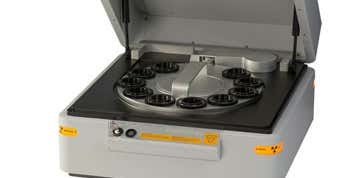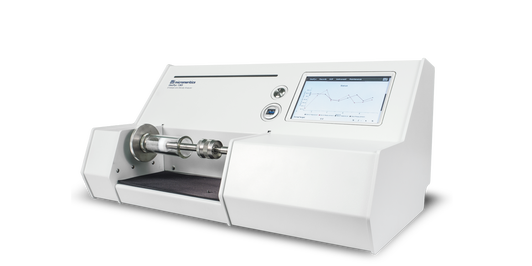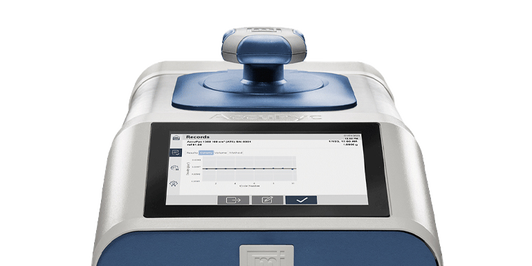고분자 분석에 사용되는 기법은 무엇인가요?
고분자는 매우 다양한 분야에 활용되므로, 이에 맞는 분석 기법 역시 다양하게 존재합니다. 고분자 물질과 제품은 R&D 단계에서 생산 라인을 거쳐 최종 사용자에게 도달하기까지, 반드시 품질과 성능이 철저히 검증되어야 합니다.
X선 형광(XRF)을 활용한 촉매 함량 분석과 고분자 사슬 분포 확인, X선 회절(XRD)을 통한 결정도 모니터링, 레이저 회절 및 정적 이미지 분석을 통한 입자 크기 및 형태 평가까지 — Malvern Panalytical은 고분자 분석의 모든 요구를 충족하는 최첨단 솔루션을 제공합니다.
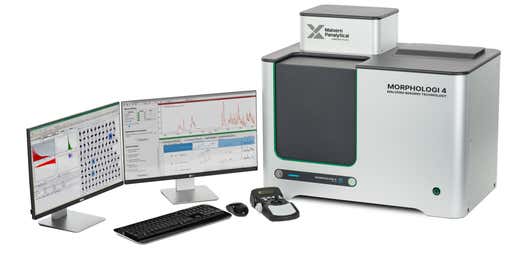
Morphologi 4-ID
X선 형광(XRF)을 활용한 고분자 분석
X선 형광(XRF) 분석은 다양한 산업에서 활용되는 신뢰도 높은 원소 분석 기법입니다. X선이 물질의 원자를 조사하면, 원자는 고유한 형광 "지문"을 방출하게 되며, 이를 통해 해당 물질의 원소 구성을 정확히 파악할 수 있습니다. 이러한 분석 데이터는 RoHS-3, WEEE, ELV 같은 글로벌 유해 금속 규제 지침을 준수하는 데 핵심적인 역할을 합니다.
Malvern Panalytical은 최첨단 XRF 기기와 함께 첨가제 및 충전제 분석용 ADPOL 및 정확한 독성 원소 분석을 위한 TOXEL 같은 고분자 특성 분석용 기준 물질도 함께 제공합니다.
- 응용 분야
- 플라스틱 재활용 과정에서 XRF는 재활용 고분자의 원소 구성을 식별하고 정량화하는 데 활용됩니다. 이를 통해 오염물질과 첨가제가 허용 기준을 초과하지 않도록 관리할 수 있습니다. 이는 재활용 공정의 조건을 최적화하고, 제품 품질을 유지하며, 관련 규제 기준을 충족하는 데 매우 중요합니다.
- 또한, XRF는 재활용 플라스틱의 기계적 및 열적 특성에 악영향을 줄 수 있는 불순물을 정밀하게 식별할 수 있어, 보다 효과적인 분류 및 처리 공정 개선에 기여합니다.
- 정밀한 원소 분석을 통해 촉매의 조성이 정확하고 활성 부위가 균일하게 분산되어 있는지 확인할 수 있으며, 이는 화학 반응에서 높은 효율성과 선택성을 확보하는 데 필수적입니다. XRF를 활용하면 연구자들은 촉매 제형을 세밀하게 조정하고, 촉매의 비활성화 상태를 모니터링하며, 더 견고하고 환경 친화적인 소재를 개발할 수 있습니다.
X선 회절(XRD)로 고분자 분석
고분자의 결정 구조와 상 조성을 조사하는 것은 고분자의 성능 특성을 이해하고 최적화하는 데 필수적입니다. 고분자 내 결정질과 비정질 영역의 배치는 다른 속성 중에서도 기계적 강도, 열 안정성, 화학적 저항에 직접 영향을 미칩니다.
Malvern Panalytical의 X선 회절(XRD) 제품에는 동급 최고 수준의 X선 회절분석기인 Aeris와 Empyrean이 포함되어 있습니다.
Aeris
- Aeris는 다기능성, 높은 데이터 품질, 그리고 재현성을 위해 설계된 테이블탑 XRD 시스템입니다.
- Aeris는 다양한 샘플 유형에서 결정질 특성을 측정해야 하는 실험실 관리자, 대학 교수, 제조 현장 전문가에게 완벽한 솔루션입니다.
- Aeris는 테이블탑 콤펙트 XRD 시스템이지만, 고가의 대형 장비 수준의 정확도와 분석 성능을 제공하며, 유지 비용이 낮고 특별한 전문 지식 없이도 쉽게 사용할 수 있는 사용자 친화적인 솔루션입니다.
Empyrean
- Empyrean 시스템은 최첨단 데이터 품질을 제공하도록 설계되었으며, 특히 고난이도의 경질 방사선 응용 분야까지 폭넓게 대응할 수 있습니다.
- Empyrean은 다양한 샘플을 정밀하게 분석할 수 있는 유일한 플랫폼으로, 항상 최상의 데이터 품질을 보장합니다. 하나의 장비로 X선 회절, 산란, 이미징 분석 등 가장 광범위한 응용 분야를 커버하는 다기능 XRD 시스템입니다.
두 기기 모두 고분자 특성 분석에 중요한 기능을 갖추고 있습니다. 바로, 하드웨어 부속품과 소프트웨어 업그레이드를 통해 손쉽게 시스템을 확장하거나 맞춤화할 수 있도록 설계되었다는 점입니다. 예를 들어, Aeris는 모듈형 설계를 채택해 다양한 부속품과 기능을 쉽게 추가할 수 있으며, Empyrean은 PreFIX 개념을 통해 복잡한 재정렬 과정 없이도 서로 다른 구성 간에 빠르게 전환이 가능해 동급 최고 수준의 유연성을 제공합니다.
이러한 유연한 설계는 지속 가능성 향상에도 기여합니다. 특히 미세 플라스틱에 대한 우려가 커짐에 따라, 향후에는 환경 피해를 방지하기 위한 고분자 선별 검사 요건이 더욱 강화될 가능성이 높습니다. Malvern Panalytical의 미래 대응형 XRD 시스템은 새로운 분석 요구에도 유연하게 대응할 수 있도록 준비되어 있으며, 이를 통해 고분자가 환경에 미치는 영향에 대해 보다 깊이 있는 통찰력을 제공합니다.
- 응용 분야
- 연구개발(R&D) 분야에서는, 고분자의 결정 구조를 분석함으로써 다양한 가공 조건과 환경 조건에서의 고분자 거동을 예측할 수 있습니다.
- 이러한 통찰력은 산업 생산 과정에서 제품 품질을 일관되게 유지하는 데에도 매우 중요합니다.
- 또한, 상(phase) 조성에 대한 이해는 잠재적인 결함과 개선이 필요한 영역을 식별하는 데 도움이 되며, 이를 바탕으로 고급 고분자 소재의 설계 및 개발에서 혁신을 촉진할 수 있습니다.
고분자 및 미세 플라스틱 분석용 레이저 회절
Mastersizer 시리즈
입자 크기를 측정하는 가장 현명한 방법
입자 크기 분포 분석은 고분자 분야에서 원료와 완제품 모두에 대한 중요한 정보를 제공하며 핵심적인 역할을 합니다. 이 분석 프로세스는 고분자의 기계적, 열 및 화학적 특성에 직접 영향을 미치는 입자 크기 범위와 분포를 분석하는 데 도움이 됩니다.
레이저 회절은 산란하는 레이저 광선의 강도에 따른 각도 변화를 측정하고, 이를 사용하여 크기 분포에 대한 정보를 도출합니다. Mastersizer 3000+는 다양한 응용에 대응할 수 있는 소형 레이저 회절 장비로, 까다로운 실험실 환경에서도 분석 요건과 워크플로에 효과적으로 대응합니다.
- 응용 분야
- 정확한 입자 크기 정보는 원료 단계에서 첨가제와 충전제가 규정된 균일성과 성능 기준을 충족하는지 확인하는 데 중요하며, 이는 생산 공정의 일관성을 확보하는 핵심 요소입니다.
- 제조 중 입자 크기 분포를 모니터링하면 응집, 불균일 혼합 등과 같은 공정 이상을 조기에 식별할 수 있어, 고분자의 가공 특성 유지에 매우 중요합니다.
- 고분자 현탁액이나 콜로이드 용액의 제조업체는 제품이 원하는 성능 기준과 산업 표준을 충족하는지 검증함으로써, 응용 분야에서의 신뢰성과 기능성을 확보할 수 있습니다.
고분자 형태 분석
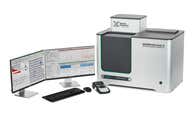
Morphologi 4-ID
Wiley의 KnowItAll® Raman Identification Pro 패키지 평가판 구독이 포함된 단일 통합 플랫폼에서 빠르고...
고분자의 형태 분석은 고분자 사슬의 배열, 분지화, 분자량이 구조적 및 기계적 특성에 어떤 영향을 미치는지를 파악하는 데 필수적입니다. 특히, 분지화(Branching)와 분자량 분포(Molecular Weight Distribution)는 고분자 특성을 결정하는 데 있어 핵심 요소입니다.
고분자 사슬의 배열—분지화 정도와 분자량 분포를 포함한—은 기계적 강도, 점도, 열적 특성, 화학적 내성 등 주요 물성에 큰 영향을 미칩니다. 예를 들어, 분지화는 고분자 사슬 간의 얽힘과 상호작용 방식에 영향을 주어 재료의 밀도와 유연성에 변화를 일으킬 수 있습니다. 마찬가지로, 분자량의 변화는 고분자의 가공성 및 전반적인 성능에 영향을 미치며, 일반적으로 분자량이 클수록 강도와 인성이 향상됩니다.
Morphologi 4-ID: 고분자 형태 분석을 위한 최적의 솔루션 정적 이미지 분석을 통해 입자 샘플의 형태를 정밀하게 파악할 수 있으며, 입자 크기와 형태 등 다양한 지표를 측정할 수 있습니다. 이 시스템은 분말층 융합(Powder Bed Fusion) 공정 등에서 사용되는 고분자 입자 분석에 특히 효과적입니다.
Morphologi 4-ID는 자동화된 이미징과 화학 성분 식별 기능을 결합하여, 고분자 구조 및 특성을 포괄적으로 분석할 수 있으며, 이를 통해 다양한 응용 분야에서 소재 성능을 최적화하는 데 기여합니다.
- 응용 분야
- 연구자들은 형태학적 매개 변수를 분석함으로써 다양한 조건에서 고분자의 거동을 예측하고 조절할 수 있으며, 이를 통해 특정 응용에 최적화된 맞춤형 소재 설계가 가능합니다.
- 고분자의 형태 분석은 전체 생산 공정에서의 품질 일관성을 확보하는 데에도 활용됩니다.
당사의 전문성
다양한 고유 특성을 지닌 최신 고급 고분자 소재는 보다 지속 가능한 소재 개발에 핵심적인 역할을 합니다. 이러한 고분자를 개발하고 제조하며 품질을 보장하기 위해서는 최첨단 기술과 전문성이 필수적입니다. 그래서 Malvern Panalytical은 여러분의 혁신 여정에 함께하는 파트너입니다.
당사의 응용 전문가들은 각 분야에서 전문성을 갖추고 여러분의 노하우와 당사의 측정 전문 지식을 결합하도록 지원합니다. 기기 제공은 물론, 작업자 교육, 샘플 준비 지원, 유지보수 서비스에 이르기까지 — 고분자 개발과 생산 전 과정에서 함께하겠습니다.

